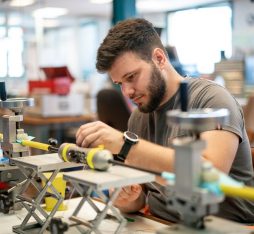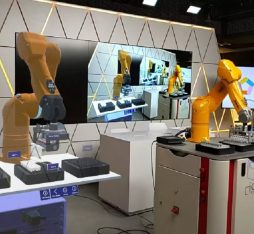With its two anechoic chambers, Orange is at the forefront of research supporting the rise of new technologies and new uses.
For two years now, Orange has had two anechoic chambers: one inaugurated on 3rd May 2016 at Orange Gardens, the Châtillon ecocampus dedicated to research and innovation, and the other on 4th November of the same year on the premises of the LEAT (Laboratory of electronics, antennas and telecommunications) on the SophiaTech campus within the framework of the CREMANT (Centre de REcherche Mutualisé sur les ANTennes: a shared laboratory between Orange Labs, the University of the Côte d’Azur, and the CNRS).
These enclosed metallic spaces, whose interior walls are covered with absorbent materials preventing reflection of electromagnetic waves, are designed on the one side to eliminate any external disturbance that could hinder measurements, and on the other to control emissions within the room over a very wide range of frequencies (30 MHz to over 100 GHz). The aim of these chambers is to measure performance of wireless communication systems, to study the risks of interference between technologies, and to measure electromagnetic compatibility of the cables.
A field of study and of measurement of antenna systems
The SophiaTech shared anechoic chamber has the particularity of being completely “deaf”. Aimed at measuring the performances of antennas for future 5G networks, the Internet of Things, or even vehicle-to-vehicle communications, providing the latter with the possibility to automatically exchange information amongst themselves, this 60 m² space accommodating antennas up to 2 m in diameter and 100 kg, enables testing in an environment that is devoid of all reflecting obstacles and interfering external signals.
The research projects carried out thanks to this facility are centred around three pillars:
● The exploration of new antenna technologies such as adaptive antennas for 5G networks, particularly for frequencies above 3 GHz, or even above 30 GHz, which, by combining a large number of antennas at transmission or at reception, enable for example an increase in the reach of mobile systems and their capacity to accommodate a larger number of users.
● The design of antennas and sensors for growth industries such as the Internet of Things, smart homes and cities, e-health, and connected autonomous vehicles.
● Software that enables modelling of the antennas so as to predict their radiation characteristics.
In order to improve the performance of this anechoic chamber, its functionalities have recently been extended. “This year the university project RANDOM@SophiaTech2.0 (a platform for the measurement of electromagnetic radiation of antennas and of diffraction up to millimetre waves of communication objects, sensors, and radar systems) financed the construction and commissioning of a compact base and of electronic equipment enabling measurement of radiation and diffraction of electromagnetic fields up to 260 GHz with a dynamic range of at least 70 dB” explains Éric Bonneau, Antennas Manager at Orange. With these extended functionalities, the project offers new possibilities for measuring active antennas (5G, backhaul…), “in far-field conditions between 3 and 200 GHz, so without resorting to tradition NF-FF (near-field-to-far-field) transformations, which require the knowledge of two field components in amplitude and phase”, specifies Éric Bonneau.
The chamber has thus become an essential tool for the characterisation of active antennas when a modulated signal is applied to them. “In order to be more agile in our experimental measurements, we made the choice to develop our own knowledge tools for these two test beds, based on the libraries of the chamber manufacturer for piloting the positioners, and on our own experience of microwave equipment control”, Éric Bonneau continues.
Measuring directive antennas in a limited space
One of the advantages of this anechoic chamber is that it is fitted with CATR (compact antenna test range) type equipment. This enables the generation, in a predefined zone of the anechoic chamber, of a quiet area (equiphase and equiamplitude, so as to recreate the far-field measurement conditions). The anechoic chamber can thus allow measurement of directional antennas at high or active frequencies (5G, backhaul…) in a limited space.
But this sophisticated and very high precision tool required special attention, in particular during its design: “The complexity of developing the chamber’s tool and the alignment of non-standard equipment coming from several providers, from across Europe and the United States, created a lot of logistical issues”, admits Éric Bonneau.
Orange’s investment in this type of tool highlights how essential research in this area is. In effect, although we may not always see them, antennas are all around us, in our computers, our mobile phones, etc. and they are now taking on new shapes, because the signals picked up are more and more subtle. Each communicating object of the future will no doubt have an antenna designed specifically for it. In this context, research, notably through anechoic chambers, is a requirement for supporting the rise of new technologies and new uses.











